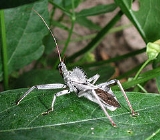
Wheel bug
Encyclopedia
The wheel bug in the family Reduviidae
, is one of the largest terrestrial true bugs in North America
, being up to 1.5 inches, or 38 mm, in length; it is the only member of its genus. A characteristic structure is the wheel-shaped pronotal armor. They are predators upon soft-bodied insects such as caterpillar
s, Japanese beetle
s, etc., which they pierce with their beak to inject salivary fluids that dissolve soft tissue. Because most of their prey are pests, wheel bugs are considered beneficial insects, although they can inflict a painful bite if handled carelessly.
Wheel bugs are common in eastern North America
, although many people in the region have never seen them. They are camouflage
d and very shy, hiding whenever possible. They have membranous wings, allowing for clumsy, noisy flight which can easily be mistaken for the flight of a large grasshopper
. The adult is gray to brownish gray in color and black shortly after molting, but the nymphs (which do not yet have the wheel-shaped structure) have bright red or orange abdomens.
The wheel bug is also noted to be very vicious in the wild, and cannibalistic behaviors between them have been noted; for example, nymphs
may prey on nymphs and the female may feed on the male after mating is concluded.
It possesses two scent sacs (red-orange in color) that can be fired from its anus, usually in reaction to being disturbed. The scent produced by it is not as powerful as that produced by the stink bug, but is still strong enough to be detected by human noses. Colors include black and gray.
Reduviidae
Reduviidae is a large, cosmopolitan family of predatory insects in the suborder Heteroptera...
, is one of the largest terrestrial true bugs in North America
North America
North America is a continent wholly within the Northern Hemisphere and almost wholly within the Western Hemisphere. It is also considered a northern subcontinent of the Americas...
, being up to 1.5 inches, or 38 mm, in length; it is the only member of its genus. A characteristic structure is the wheel-shaped pronotal armor. They are predators upon soft-bodied insects such as caterpillar
Caterpillar
Caterpillars are the larval form of members of the order Lepidoptera . They are mostly herbivorous in food habit, although some species are insectivorous. Caterpillars are voracious feeders and many of them are considered to be pests in agriculture...
s, Japanese beetle
Japanese beetle
The beetle species Popillia japonica is commonly known as the Japanese beetle. It is about long and wide, with iridescent copper-colored elytra and green thorax and head...
s, etc., which they pierce with their beak to inject salivary fluids that dissolve soft tissue. Because most of their prey are pests, wheel bugs are considered beneficial insects, although they can inflict a painful bite if handled carelessly.
Wheel bugs are common in eastern North America
North America
North America is a continent wholly within the Northern Hemisphere and almost wholly within the Western Hemisphere. It is also considered a northern subcontinent of the Americas...
, although many people in the region have never seen them. They are camouflage
Camouflage
Camouflage is a method of concealment that allows an otherwise visible animal, military vehicle, or other object to remain unnoticed, by blending with its environment. Examples include a leopard's spotted coat, the battledress of a modern soldier and a leaf-mimic butterfly...
d and very shy, hiding whenever possible. They have membranous wings, allowing for clumsy, noisy flight which can easily be mistaken for the flight of a large grasshopper
Grasshopper
The grasshopper is an insect of the suborder Caelifera in the order Orthoptera. To distinguish it from bush crickets or katydids, it is sometimes referred to as the short-horned grasshopper...
. The adult is gray to brownish gray in color and black shortly after molting, but the nymphs (which do not yet have the wheel-shaped structure) have bright red or orange abdomens.
Characteristics
The wheel bug has characteristic dorsal armor, shaped like a wheel or cog. It moves and flies slowly, and in flight produces a noisy buzzing sound. It has one of the most developed set of mouth parts among true bugs. Its beak arises from the anterior end of its long, tubular head and unfolds forward. The bug plunges its beak into its victim, pinning its prey with its front legs. It then injects enzymes into the victim, paralyzing it and dissolving its insides, and proceeds to drain all of the victim's bodily fluids. The bite of a wheel bug is painful and may take months to heal (sometimes leaving a small scar), so caution is highly advised when handling them.The wheel bug is also noted to be very vicious in the wild, and cannibalistic behaviors between them have been noted; for example, nymphs
Nymph (biology)
In biology, a nymph is the immature form of some invertebrates, particularly insects, which undergoes gradual metamorphosis before reaching its adult stage. Unlike a typical larva, a nymph's overall form already resembles that of the adult. In addition, while a nymph moults it never enters a...
may prey on nymphs and the female may feed on the male after mating is concluded.
It possesses two scent sacs (red-orange in color) that can be fired from its anus, usually in reaction to being disturbed. The scent produced by it is not as powerful as that produced by the stink bug, but is still strong enough to be detected by human noses. Colors include black and gray.

